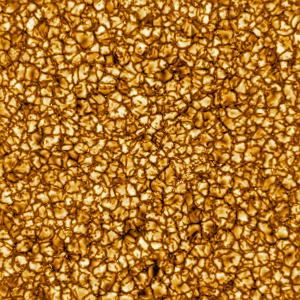First-of-their-kind images of the Sun from new Haleakalā telescope
University of Hawaiʻi at MānoaLINK TO VIDEO AND SOUND (details below): https://bit.ly/3aWHhzg
WHAT—Never-before-seen images of the Sun reveal cell-like structures the size of Texas roiling on its surface. These are the very first images observed by the National Science Foundation’s Daniel K. Inouye Solar Telescope (DKIST).
WHO—The $344 million Inouye Solar Telescope is the world’s largest, most powerful solar telescope. Scientists from the University of Hawaiʻi at Mānoa’s Institute for Astronomy (IfA)helped build two infrared instruments for DKIST that ultimately will allow scientists to predict the Sun’s magnetic activity and solar storms.
WHERE—Haleakalā summit, Maui
WHEN—Imagery just released to researchers, general public on Wednesday, January 28.
WHY—The telescope will become fully operational in July 2020, but scientists continue to conduct preliminary tests by making observations of the Sun. DKIST is designed to map the magnetic fields within the Sun’s corona, where solar eruptions occur that impact life on Earth. Solar activity can disrupt air travel, cause blackouts and disable technologies such as GPS used for navigation.
OTHER FACTS:
-
DKIST will be even more powerful as more state-of-the-art instruments come online in the coming months.
-
IfA constructed a pair of complex instruments for the telescope. The first is called the Cryogenic Near-Infrared Spectropolarimeter (CryoNIRSP). The nearly 2-ton instrument is built to measure the Sun’s magnetism beyond the visible solar disk. The second, is the Diffraction-Limited Near-IR Spectropolarimeter (DL-NIRSP), that will allow DKIST to view the evolution of the Sun’s magnetic fields in extreme detail.
-
The unusual optical design of the 4-meter telescope allows it to measure the Sun’s magnetism out into space. It is also modeled after the UH/IfA designed proof-of-concept Scatter-free Observatory for Limb Active Regions and Coronae (or Solar-C) telescope, in operation on Haleakalā since 2001.
-
As part of the DKIST, the National Science Foundation awarded UH Maui College a $20-million grant to engage Native Hawaiian students to pursue careers in science, technology, engineering and math (STEM).
-
Construction on the DKIST site began in January 2013
VIDEO BROLL (1minute 37 seconds)
0:00-0:12, 2 clips: First images of Sun detected by DKIST
(video shows boiling gas covering Sun, the cell-like structures are each about the size of Texas. Scientists say the imagery could unlock why the outer atmosphere of the Sun is more than a milllion degrees )
0:21-0:31, 3 clips: Exterior of solar telescope
0:31-0:55, 4 clips: Interior of solar telescope
0:55-1:01: Instrument at heart of telescope that took first images
1:01-1:07: Instrument UH IfA built
1:07-1:25, 3 clips: Telescope under construction
1:25-1:37, 2 clips: Exterior of Institute for Astronomy at UH Mānoa
SOUNDBITES:
Jeff Kuhn, UH Mānoa Professor (8 seconds)
It is literally the biggest jump in humanity’s ability to study the Sun from the ground since Galileo’s time so it’s a big deal.
Jeff Kuhn, UH Mānoa Professor (11 seconds)
What it does is see the development of sunspots and small magnetic features of the sun that we know ultimately are responsible for the storms that create the interaction with the Earth.


